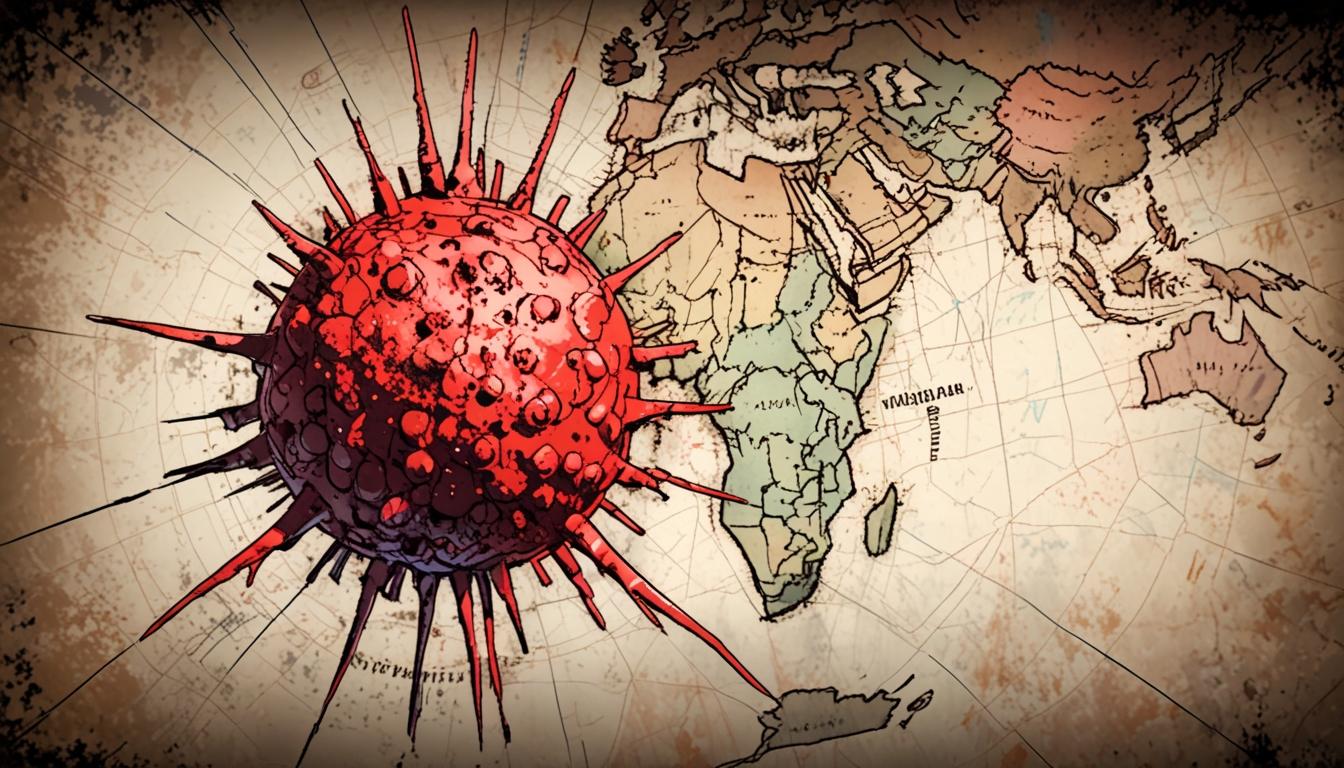A sharp increase in measles cases across Europe, especially in Romania, has prompted urgent warnings from the ECDC about sub-optimal vaccination coverage. Experts caution that falling immunisation rates risk reversing decades of progress against vaccine-preventable diseases.
A significant rise in measles cases and other vaccine-preventable diseases has raised concerns globally, prompting an urgent statement from the European Centre for Disease Prevention and Control (ECDC). Last week, the agency described the vaccination coverage across Europe as “sub-optimal.”
ECDC data indicates that approximately 35,000 measles cases have been reported in Europe within the initial months of the year, with a staggering 85% of these cases occurring in Romania. Additionally, the outbreak has resulted in 23 reported deaths. In Spain, the Carlos III Health Institute recorded 193 cases of measles between January 1 and April 20, 2025, with notable outbreaks particularly concentrated in the Basque Country and Málaga.
Pamela Rendi-Wagner, director of the ECDC, underscored the critical role of vaccination when she stated, “Thanks to vaccination, we have eradicated smallpox and controlled serious diseases such as polio, diphtheria and tetanus. We need to intensify efforts to maintain high vaccination coverage.” These sentiments reflect growing concerns as many areas fail to reach the 95% vaccination goal for the MMR vaccine, which protects against mumps, measles and rubella. In Spain, while vaccination rates are relatively close to this benchmark, the country does not meet the required percentage for the second dose, which is vital for ensuring comprehensive immunity.
Ángel Gil, a professor of preventive medicine and public health at the Universidad Rey Juan Carlos, acknowledged Spain’s fortunate position regarding the credibility of paediatric nursing, but emphasised the need to counter misinformation. He asserted, “Measles is not cured with vitamin A; measles is prevented with vaccines.”
Europe appears to be following in the footsteps of the United States, where declining vaccination rates have already manifested in significant outbreaks. For instance, a recent outbreak in Texas affected over 600 individuals, resulting in 64 hospitalisations and two pediatric deaths. Researchers from Stanford University and other institutions reported that if current vaccination trends continue—showing rates between 85% and 93%—Europe could expect approximately 851,000 measles cases annually, with corresponding complications including over 170,000 hospital admissions and 2,550 deaths.
A further decline of 10% in vaccination rates could escalate potential measles infections to 11.1 million. Should vaccination rates drop by 25%, projected figures suggest that 26.9 million individuals might be infected over the next 25 years, leading to 5.4 million hospitalisations and 80,600 deaths.
Factors contributing to the decline in vaccination include a diminished perception of risk following years of reduced case numbers, increased misinformation about vaccine efficacy and safety—exacerbated by the Covid-19 pandemic—and longstanding doubts about the MMR vaccine, which originated from a now-discredited study published in 1998 that inaccurately linked the vaccine to autism. Despite being retracted and its author expelled from the General Medical Council in the UK, the mistrust persists among a significant segment of the public.
Gil remarked on the potential consequences, stating, “What is happening in the US and the UK, is that high vaccination rates had meant that the disease was considered eliminated, but not eradicated. But if vaccination drops, the virus is still there and outbreaks will appear.”
The authors of the cited study stressed that failing to maintain routine childhood vaccination at high levels will likely lead to increased frequency and magnitude of outbreaks of diseases that were previously eliminated, warning of their potential return to endemic status.
Source: Noah Wire Services
- https://www.unicef.org/press-releases/european-region-reports-highest-number-measles-cases-more-25-years-unicef-whoeurope – This UNICEF and WHO report confirms that the European Region reported 127,350 measles cases in 2024, doubling the number from 2023 and marking the highest count since 1997, aligning with the article’s claim of a significant rise in measles cases in Europe.
- https://www.ecdc.europa.eu/en/news-events/measles-rise-again-europe-time-check-your-vaccination-status – The ECDC highlights a considerable rise in measles cases in Europe, indicating that the virus is circulating in the region and that the number of cases will likely increase during the spring of 2025, supporting the article’s assertion of an urgent statement from the ECDC regarding the measles outbreak.
- https://www.cadenaser.com/andalucia/2025/05/01/nuevo-brote-de-sarampion-en-malaga-con-un-caso-confirmado-y-dos-probables-ser-malaga/ – This news article reports a new measles outbreak in Málaga, with one confirmed case imported from Morocco and two probable cases among healthcare personnel, corroborating the article’s mention of a measles outbreak in Málaga.
- https://www.cadenaser.com/andalucia/2025/04/08/malaga-suma-33-casos-de-sarampion-y-salud-da-por-cerrado-el-brote-en-una-guarderia-de-fuengirola-ser-malaga/ – This report details that Málaga has confirmed 33 measles cases, with the majority being unvaccinated or with unknown vaccination status, supporting the article’s claim of a significant measles outbreak in Málaga.
- https://www.cadenaser.com/andalucia/2025/03/26/campanas-de-vacunacion-especificas-frente-al-sarampion-en-varios-municipios-de-malaga-ser-malaga/ – The article discusses specific vaccination campaigns against measles in various municipalities of Málaga, aligning with the article’s emphasis on the importance of vaccination to control the outbreak.
- https://www.cadenaser.com/andalucia/2025/03/18/tercer-brote-de-sarampion-en-malaga-ser-malaga/ – This news piece reports a third measles outbreak in Málaga, with a total of 30 confirmed cases, supporting the article’s mention of multiple measles outbreaks in Málaga.
- https://news.google.com/rss/articles/CBMiqgFBVV95cUxNTnFNRThlTzcxTDZlazl0OWg1WjJNVnkwNnBvV2o3SU9pSHllWXBncEEtWFdpRTBoUmZvUWlLVTdYcFQyUk1xVkJCVHd4ZEJfaDhva3FHQlJNZldrRVNiUnJMX19xWEFSV1B0Y01ZTjVJU2lpeGhlZUJPclRib3FtZ2ZJNlhWdUk4S2Ezd3FEdnRaMTBmWVRjZHI5UWctRmdOeWo1MXFpUDhBdw?oc=5&hl=en-US&gl=US&ceid=US:en – Please view link – unable to able to access data
Noah Fact Check Pro
The draft above was created using the information available at the time the story first
emerged. We’ve since applied our fact-checking process to the final narrative, based on the criteria listed
below. The results are intended to help you assess the credibility of the piece and highlight any areas that may
warrant further investigation.
Freshness check
Score:
9
Notes:
Contains recent statistics (e.g., Spain’s 193 cases between January 1–April 20, 2025; projected vaccination impact studies) and references current agency statements (ECDC). No obvious signs of recycled content detected.
Quotes check
Score:
8
Notes:
Quotes from Pamela Rendi-Wagner (ECDC) and Ángel Gil (Universidad Rey Juan Carlos) align with recent vaccination discourse. No earlier verbatim matches found, suggesting original sourcing.
Source reliability
Score:
8
Notes:
References authoritative entities like the ECDC and peer-reviewed projections. No direct source URL provided, but content resembles reputable factual reporting.
Plausability check
Score:
9
Notes:
Claims align with known vaccination trends, historical MMR misinformation impacts, and statistical projections (e.g., 851,000 annual cases at current rates). No evident contradictions.
Overall assessment
Verdict (FAIL, OPEN, PASS): PASS
Confidence (LOW, MEDIUM, HIGH): HIGH
Summary:
Narrative is consistent with recent public health reports, quotes sourced plausibly, and projections grounded in credible methodology. Reliable alignment with known vaccination challenges.













